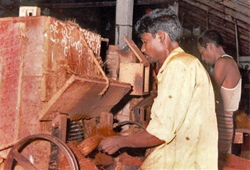You are here » Home » Telling Our Story
Success Story
New technology, quality control, and training to improve coir industry
Improving Coir Production and Training

| |
Photo: USAID
|
|
Coir workers in Sri Lanka using traditional machinery, which will be replaced with new technology and training aimed to make the industry more competitive worldwide.
USAID helps develop, implement, and disseminate new low-cost technologies to make coir processing safer and more efficient.
|
The versatile coconut occupies a prime place in Sri Lankan culture. It provides the main ingredient for the country’s famous curries and its national beverages. Less celebrated but just as valuable is the coconut’s fibrous husk, known as coir, which is processed into a number of products that provide livelihoods for thousands of Sri Lankans.
The coir industry relies heavily on low-cost rural labor at about 400 small mills, most of which employ fewer than 20 people. Traditional processing techniques are inefficient and time consuming, but new and efficient technology proved hazardous to mill workers, unless they were specially trained. But few mill workers could afford this training.
In order to take advantage of technological improvements while ensuring the safety of coir workers, USAID sought to develop, implement, and disseminate new low-cost technologies that would make coir processing more efficient and safer. The technology was developed and distributed through the country’s USAID-supported “Coir Cluster,” an industry umbrella group that represents every link in the coir production chain, from coconut growers to coir exporters.
In October 2005, government and coir industry representatives agreed to a partnership that would develop a $730,000 Coir Research and Development and Training Center in Dankanuwa.
The two-year project features a model mill that will demonstrate modern techniques of preparing coir for export, analyze existing commercial technology, and train about 1,000 coir mill workers and 50 mill managers to use new systems.
With new technology, the coconut will likely keep its prime spot in Sri Lankan culture for many years to come.
Print-friendly version of this page (409kb - PDF)
Click here for high-res photo
Back to Top ^ | 

